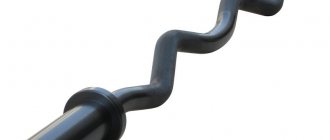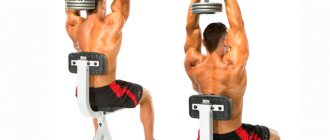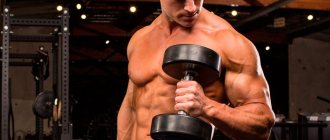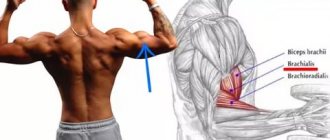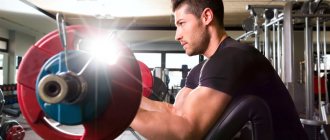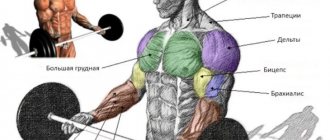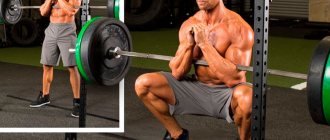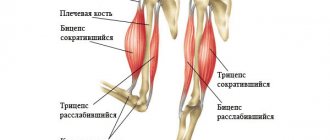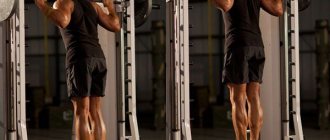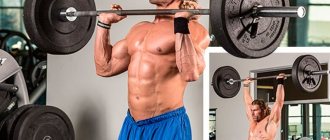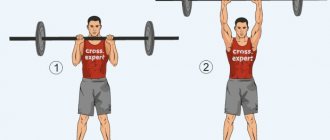Good day, comrade!
From this sports issue you will learn about various modifications of the barbell biceps curl (BRC) with emphasis on different heads. The material will be useful if you need developed biceps.
1. Lifting the barbell for biceps with a wide grip
The classic form of the exercise. We bring our elbows forward and work within the amplitude. This method works well on the inner (short) bundle of your biceps. A wide grip shifts the load to the internal beam.
2. Close-grip biceps curl
Shifts the load to the outer beam. However, you need to take into account that the elbows are brought forward (this is the emphasis on the internal beam). This results in an increase in amplitude and a more complete development of both beams due to the extension of the elbows and a narrow grip. You get more work done. You can lift more weight by including two beams (more evenly).
3. Barbell Curls with Elbows Back
With this form of exercise, the amplitude is reduced, but the load is shifted to the external beam, which is very difficult to involve in work. If you use a narrow grip in such a situation, this will further emphasize the load on the external beam.
4. Concentrated barbell curl
Typically, such curls are done with a dumbbell. However, this can be easily done with a barbell. With this form, the peak of your biceps is worked out very well, if there is a genetic predisposition. You can rest on your knees (as on the Scott bench), or you can not rest. This is good for situations where you have limited inventory.
5. Barbell curl with reverse grip
It works well on the “cushion” under our biceps (brachial muscle). It is very important not to cheat in this exercise because there is no cushioning clearance. You may tear muscles or ligaments. The brachialis muscle takes up 50 to 70% of any biceps curl, so it makes sense to work it well. I usually do hammer curls because they are more convenient. However, if you don't have dumbbells, you can grab a barbell and do reverse-grip curls. In addition, this exercise works great on your forearms.
6. Seated biceps curl with partial range of motion
This form puts constant tension on your biceps because you can't rest the bar on your knees. This constant tension is great for your biceps. At the very end, you can cause death to your biceps by holding until complete failure.
We recommend Underground 0. How to catch supercompensation by the tail?
7. Lifting the barbell for biceps according to system 21
The point is that three types of amplitude are used during one set of 21 repetitions (7 for each type without rest).
- Lower range - 7 reps
- Upper range - 7 reps
- Full range of motion - 7 reps
This circuit is great at getting blood into your biceps. This works especially well at the end of a workout.
8. Barbell curl with cheating
Cheating on the biceps is dangerous. Beginners should not do this because it requires good whole-body consistency and a good understanding of biceps involvement. Cheating is a situation where you help your body throw weight up. This makes the load lighter at the end of a set (when you don't have the strength to do a full rep), or when you're using a lot of weight to work in the negative phase. You use your whole body to help throw the weight up, and then lower it down under control. This way you can overcome heavier weights.
Advantages and disadvantages
Advantages:
- This exercise develops not only volume, but also muscle strength.
- When performing an exercise with a barbell in a standing position, additional muscles are involved in the work, so you can perform biceps curls using large weights.
Flaws:
- In the same way, the last advantage can also be attributed to the disadvantages, because it will not be possible to perform a “pure” technique. Often, after lifting a lot of weight, an athlete performs a movement using cheating.
- Another disadvantage is the risk of injury, since when working with heavy weight, the load on the spine increases.
Curved EZ-bar
The Curved EZ Bar is a way to reduce excessive stress on your elbows and wrists. It is believed that it more effectively engages the biceps muscles. In addition, with a curved barbell it is easier to perform reverse raises when the palm is facing down - in this case, the load on the forearms increases.
This variation is suitable for both beginners seeking to develop the neuromuscular connection with the biceps and advanced trainees. In their case, the EZ bar exercise can be performed on a Smith bench (that is, with the elbows supported).
Why does my back hurt?
The main mistake when performing biceps curls is using an overly heavy barbell. In fact, the biceps muscles simply do not have enough strength to lift the weight, and the load is transferred to muscles that should not be involved in the exercise at all.
The second mistake is turning your head in an attempt to control the technique of performing the exercise in the mirror. However, since biceps curls involve the muscles of the shoulder girdle and neck, turning the head under load can cause unpleasant pain in the neck and even displacement of the vertebrae.
Execution technique
- Take a position in front of the mirror, holding the barbell in your hands.
- Feet should be shoulder-width apart.
- Hands with the bar are lowered to the bottom.
- The grip can be narrow, straight or wide. The placement of the hands on the bar creates an emphasis on part of the target muscles: the wider the grip , the more the long head of the biceps works, and the narrower the grip , the more the short head is worked.
- Please note that your back should be straight throughout the entire exercise.
- The upward movement, lifting the barbell, is performed while exhaling.
- The peak amplitude will occur at the moment when the arms are fully bent at the joints.
- As you exhale, the barbell lowers to your thighs.
- Do not tilt your body to the sides under any circumstances.
Biceps anatomy
Now I will not dwell on the anatomy of the biceps and its detailed structure, because... I discussed it in detail in an article on the anatomy of the hands.
That article contains all the necessary knowledge about the structure of the arm muscles, but I still hasten to repeat to you some necessary points.
This is what the anatomy of a biceps looks like:
The biceps (biceps brachii) is a large muscle, clearly visible on the front surface of the shoulder, consisting of two heads (“bi” = two).
- Long head (long tendon, but small part of the biceps): Found on the outer part of the biceps.
- Short head (short tendon, but most of the biceps): Found on the inside of the arm.
Both heads of the biceps are attached to one tendon, which is attached to the elbow joint.
The tendon itself is not attached exactly to the bone, but slightly inward, to the side of the forearm, so the biceps not only bends the arm at the elbow joint, but also SUPINATES (rotates) it towards the thumb.
The inner head (short) of the biceps grows from almost any flexion, but to grow the outer (long) head you need to do one simple manipulation: MOVE YOUR ELBOW BACK!
If your elbows are located slightly behind, then the long head of the biceps is connected.
This happens because anatomically, the outer head of the biceps is attached to the shoulder joint at the top, so to engage it, you NEED TO PULL YOUR ELBOW BACK. Mechanically, this will make it work.
The saddest thing is that practically NO ONE does this! Everyone just hammers the inner head according to the classics, because... the elbows are brought forward, and the outer one often lags behind.
- Also, if you bring your hands narrowly on the barbell, then the OUTER HEAD OF THE BICEPS works more.
- If you grab the barbell widely, the inner head works more.
Conclusion:
- If our elbows are brought forward during biceps curls: the INNER (short) head of the biceps works.
- If our elbows are pulled back during biceps curls: the OUTER (long) head of the biceps is working.
- The hands on the fingerboard are narrow = the outer head works.
- Brushes on the fingerboard wide = inner head works.
Here's a little life hack at the very beginning.
Thus, with the help of the same exercises, but in different variations, for example, the classic biceps curl, which we will talk about today, you can pump up the entire array of your biceps.
It is very comfortable.
How to implement it into training.
The standing biceps curl exercise is performed first in the biceps complex, and the biceps complex itself can be combined with back exercises. As an example, let's look at a back-biceps workout:
- Pull-ups on the bar with weights with a wide grip.
- Head pull-ups.
- Reverse close grip pull-ups.
- Bent-over barbell row.
- Wide grip bicep curl.
- Standing dumbbell biceps curls with supination.
- Hyperextension.
And also read: Lifting dumbbells for biceps while standing → Lifting dumbbells for biceps while sitting → Lifting the EZ-bar for biceps →
Neck selection
There are many types of bars that can be used to build impressive arm muscles. But let’s look at the most popular representatives of iron sports. There are W-shaped, EZ-shaped and classic straight. The differences between the first two necks are minimal except for a few small details.
The W bar is ideal for working the triceps due to the angle of the handle, while the EZ bar is ideal for biceps. This bar can significantly reduce pressure on the wrists, reducing tension on the wrist joint.
This bar also allows you to work the inner head of the biceps. Therefore, it is good to alternate classes with a straight bar. Scientists have proven that when using a straight bar, the load on the biceps is significantly greater than when using an EZ bar, but if you have weak forearms, then you should initially use an EZ bar.
Too much cheating
About the third repetition of the first approach, you realize that you have already made mistakes number 1 and 2. You forgot to warm up, and you grabbed the projectile too heavy. Really heavy!
What's the solution? Reduce weight? Whatever the case! Instead, you use jerks and twist your entire body as much as you can to complete all 8 reps.
We've all done this before, but that doesn't mean we were right. In fact, such cheating steals the load from the biceps and redirects it elsewhere - including to the vulnerable lower back.
If you're using a light power pulse, do it at the very end of the last set, working down the weight when your biceps are already tired and you want to really wear them out.
Error 2. Incomplete extension of the arms
Some athletes, in order to impress their colleagues in the iron shop, hang a bunch of weights on a barbell and then cheat in the eccentric phase of bending. Instead of fully extending their arms and lowering them down, they extend them partially and lean forward. From the outside it seems that they lowered the bar, but this is not so.
When this technique is used intentionally, it is called partial repetitions. But if you are trying to lift a barbell with an prohibitive weight, this is already cheating. Full range of motion training is much more effective for developing strength and mass. If possible, look at yourself in the mirror and make sure you fully extend your arms.
How to lift while sitting on a “prayer bench”
The exercise can also be performed on the so-called “prayer bench,” which is more often called the Scotus bench. The execution technique will be as follows:
- sit on a bench, adjusting the height to your own height;
- rest your elbows on a special support;
- take the barbell from below, lift it upward with force by bending the elbow;
- Slowly lower the barbell back after reaching the top point and pause for a couple of seconds.
In this case, it is better to choose a light weight. The bench helps to isolate the biceps as much as possible by fixing the arm in a stationary position.
Lifting the barbell for biceps: which muscles work, execution and guidelines
Lifting a barbell for biceps is an isolated exercise, that is, only one joint is involved in the work - the elbow. This is one of the most common trainings for the biceps brachii muscle (biceps), it is extremely effective, allows you to efficiently work out the target muscles, increases the volume of the biceps muscle, gives it relief and increases strength parameters.
In addition to the outer and inner biceps, this exercise uses the brachialis muscle, the brachioradialis muscle (located on the outside of the forearm) and the pronator muscle (the wide part of the forearm at the elbow). If the execution technique is strictly followed, then the load does not go to any other muscles, regardless of position and grip.
Please note that the barbell curl is variable: it can be performed with a straight or reverse grip, or you can use a straight bar or an EZ bar (sometimes called a “bent” or “crooked” bar). The training is carried out standing, sitting, on an inclined bench, and on a special simulator - a Scott bench. You can also change the grip width, and all these are conceptual points that significantly shift the load towards one or another biceps bundle and additionally “load” one or another muscle from the above list.
This option assumes that the athlete stands straight, the width of the legs is not important, the main thing is that your position is balanced and comfortable for you. It is better to position yourself in front of the mirror to clearly control every movement. You can take any bar with any grip (we will go into more detail on these points below). So, the basic technique includes the following instructions:
- In the starting position, the arms are straightened at the elbow joints, the back is straight, the shoulders are lowered, the elbows are clearly fixed and do not change their position until the end of the approach.
- The athlete begins to lift the barbell in a wide arc, bending his elbows. The work is performed only with the biceps, the body is motionless, cheating is permissible only in strictly specified cases.
- After the bar has reached its peak point, the athlete begins to lower it to the starting position. Raising and lowering are performed at a moderate and comfortable speed.
The number of approaches and repetitions in standing biceps curls depends on the athlete’s goal; we will return to this issue later. An accentuated program of exercises for the biceps muscle must begin with this training; it is complex in nature and the most universal.
Working with a barbell on the biceps muscle in a sitting position can involve two options - on a regular bench and on a special Scott bench. In the first case, the athlete sits on any comfortable bench (with or without a backrest - it doesn’t matter), straightens his back, spreads his shoulders and lowers his hands with the bar to his feet.
Throughout the exercise, the elbows and shoulders remain motionless, the arms are bent at the elbows and thus only the forearm moves. This training is very specific, as it does not allow you to straighten your arms completely. The bar moves over a short amplitude, which does not make it possible to properly work out the biceps. However, in this position you can work with large weights, that is, the exercise has a specific goal - a purely increase in strength parameters, work on volume and relief is excluded. This training is used very rarely and only by armlifters for whom strength is a priority.
The barbell curl on the Scott bench is no less common than the classic standing curl. When an athlete is on a Scott bench, he is not able to help the biceps muscle with other muscles; cheating is simply impossible. This is a powerful, focused work on both biceps. The technique is as follows:
- The athlete takes a comfortable position on the Scott bench, “puts out” his arms in front of him, completely straightening them at the elbows.
- Then the athlete grabs the bar with both hands and begins to lift it over a wide amplitude towards the shoulders.
- After the barbell (straight or EZ bar) reaches the peak point, when the elbow joint is fully bent, the athlete smoothly returns the barbell to the starting position.
- At the end of the lowering phase, you do not need to fully straighten your arms; they should remain slightly bent at the elbow joint so that the biceps remains “loaded” throughout the exercise and the joint itself is not overstrained.
The number of approaches and repetitions is variable. From a biomechanical point of view, working the biceps muscle while sitting is more difficult than working in a standing position. This is a more isolated, more focused workout that perfectly works the target muscles, increasing size and increasing strength.
There is also an option for doing biceps curls on an incline bench. In this case, the athlete lies with his chest on a bench, the back of which is located at an angle of forty-five degrees (this angle is considered the most optimal). The elbows are fixed along the body and remain static during the entire exercise. The lift of the bar is carried out in a wide arc from a position with straight arms to the peak point while the elbow can bend.
Obviously, this is not the most comfortable position, since someone must present the bar to the athlete and therefore take it away. The effectiveness is also questionable: lying on an inclined bench, the athlete fixes the body, this prevents him from using additional muscles, reducing the likelihood of reflex cheating. Actually, this is the only “advantage” of this training, which in no way offsets its objective inconvenience. If isolated work on the biceps muscle is necessary, then it is much more effective to lift the barbell while sitting on a Scott bench.
There are many legends regarding which bar is more effective when working on the biceps brachii muscle - straight or “bent” - but from the point of view of biomechanics the difference is obvious. The physical difference is the placement of the wrists. And here's how it affects the functionality:
- The straight barbell comprehensively includes the “flexor”, that is, the biceps muscle and all other muscles involved in the process of flexing the elbow joint. This is a universal exercise, it is most effective and suits absolutely everyone.
- The fact that when grasping the EZ bar, the wrists are turned slightly inward indicates that the load during the lift will be emphasized on the inner biceps. This affects both volume and strength indicators. The EZ-Barbell is convenient to “finish off” the biceps muscle after 1-2 exercises have already been completed.
When it comes to grip options, there are conceptually two criteria. In terms of wrist position (palm facing up or down), the grip can be forward or reverse, and in terms of width - medium, wide and narrow. It does not matter whether the biceps curl is performed seated with an EZ barbell or with a straight bar, or whether it is a standing position. It is only important to understand the specifics of this or that position of the hands:
- Straight grip. Versatile and most productive. Suitable for both beginners and professionals, it comprehensively “loads” all target muscles.
- Reverse grip. Its specificity lies in the fact that the brachialis is actively involved; the development of this muscle directly affects the volume and relief of both bundles of the biceps brachii muscle. That is, the reverse grip is extremely useful, but never make it the first exercise; first you need to properly work out the biceps muscle itself.
- Standard grip. This is considered to be the natural positioning of the hands at approximately shoulder width; it allows the athlete to work without any negative sensations, and is the most versatile and most effective.
- Wide grip. You don’t need to be an expert in the biomechanics of the human body to understand that with a wide grip (much wider than the shoulders), the emphasis shifts to the outer bundle of the biceps brachii muscle.
- Narrow grip. Accordingly, with a narrower grip (substantially narrower than shoulder width), the main work goes to the inner biceps. Both options - wide and narrow - are more isolated compared to the standard one; they are suitable only for advanced level athletes who clearly understand which beam they need to “finish off” at this stage of training.
In other words, in most cases, lifting the barbell while standing or sitting is adequately performed with a standard grip. Wide and narrow are rather conventional concepts; they are specific and are not widely used either in bodybuilding or powerlifting. A variable grip makes sense only after several years of intense training, when the athlete sees a real need to “refinement” one or another biceps bundle.
Please note that the EZ bar curl (also called the Z bar) can be used by beginners as well. It allows you to significantly accelerate the qualitative increase in biceps volume, but there is no need to perform it every workout. On the other hand, if you have time and energy, nothing should stop you, the main thing is not to overload your hands.
Barbell curls on a Scott bench, incline bench or standing using any grip and any bar can be easily “tailored” to a specific goal. It all depends on the number of approaches and repetitions:
- A program that includes 3-4 sets of 10-12 repetitions leads to an effective increase in volume and improvement of relief.
- When working specifically on volume, 3 sets of 8-10 repetitions with mandatory weight progression is enough.
- When focusing on relief work, the weight is usually changed only once (between the first and second approaches); in total, about 4 approaches are performed and at least 10 repetitions in each.
- Strength work has conceptual differences - the number of approaches is no more than 3, maximum weights are used, the number of repetitions can be from 4 to 6.
The nuances of using grips and different bars were indicated above. Now you need to dwell on important tips and common mistakes that need to be taken into account when performing any exercise:
- The elbows and shoulders are always in the same position, only the forearm moves. Otherwise, the load will simply leave the target muscles, and the exercise will lose the lion's share of its effectiveness.
- Never bend your wrists, as this can cause injury when lifting heavy weights. Clenched fists are always in line with the forearms.
- When you work with significant weights, do not be lazy to purchase wrist bandages. Additional wrist bracing will significantly reduce the risk of injury.
- In those variants where cheating is acceptable, do not throw the barbell by arching your back; with heavy weights, you can injure yourself in the spine. It’s better to slightly bend your knees and sharply straighten them in the initial phase of the upward movement of the bar, giving yourself additional momentum.
- It is appropriate to use cheating only in extreme repetitions of an extreme approach in order to increase strength indicators. If half of the approach is done with cheating, the training loses its meaning.
- The best option for cheating is the help of a friend. Another athlete can push the bar slightly upward during the initial phase of the movement. This will make the lift easier, but will not take much of the load off your muscles.
- Do not throw the sports equipment as high as possible; your actions are limited by the elbow joint - as soon as it stops bending (provided that the elbows themselves are motionless), you can begin lowering.
- Don't go for heavy weights, this is the fastest way to the emergency room. The biceps brachii muscle requires high-quality and systematic development; if you follow the technique, you will get a guaranteed result.
Often, trainers advise keeping your elbows close to your body; this is not conceptual, but for beginners, this simple tip allows you to better control the joint by keeping it stationary throughout the approach. All these instructions are quite enough to get high-quality and effective training, but if you have any questions, you can always ask them in the comments to this article, and the Silver medalist of the World Powerlifting Championship Ethila Russia Evgeniy Volosky will definitely answer you. Be healthy, and remember that hard work overcomes even talent and genetic predisposition!
We recommend reading:
- Barbell squats - technique
- French bench press - execution options
- French standing press - execution options
- Lifting dumbbells for biceps - execution technique
- Lifting dumbbells in front of you - options and technique
